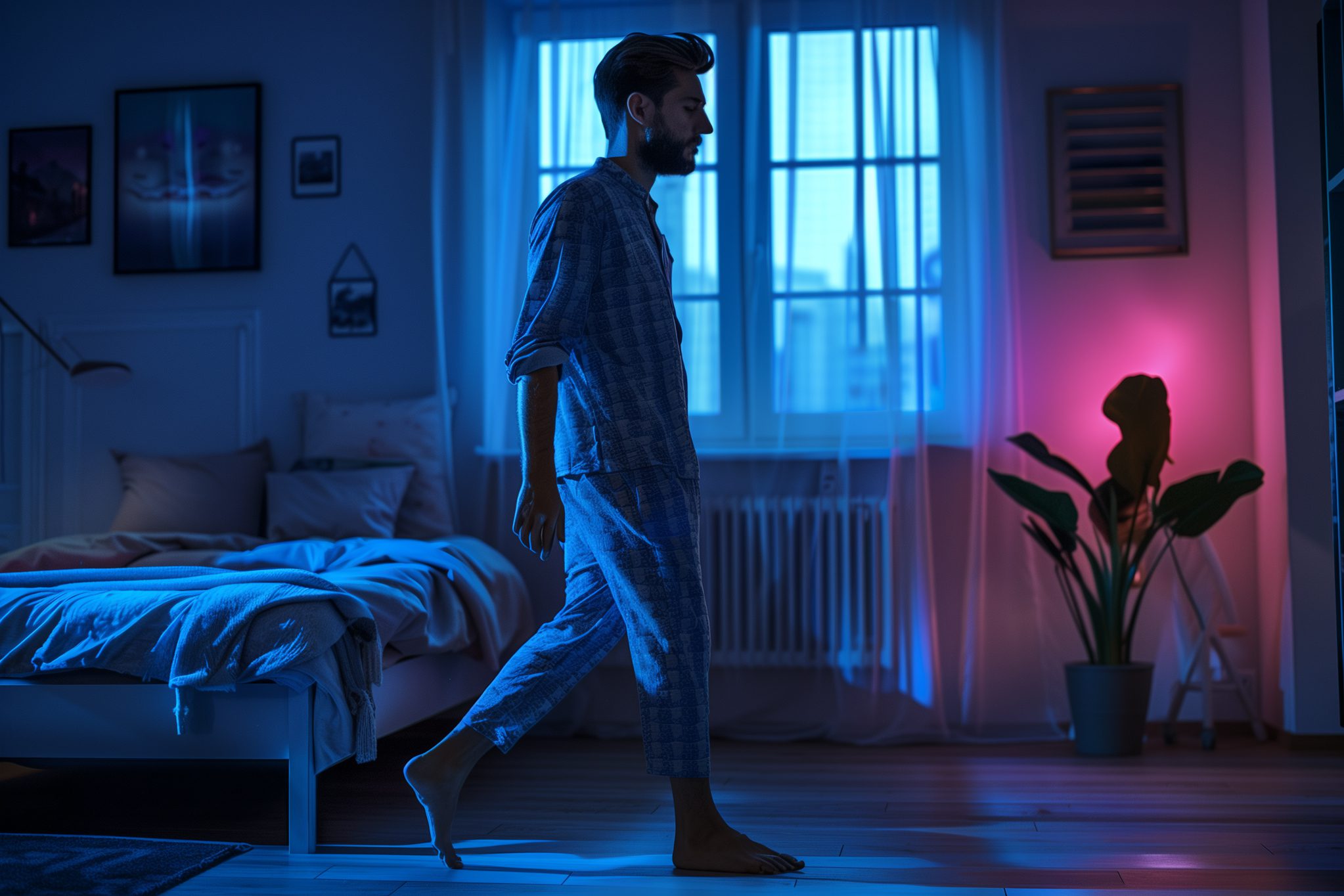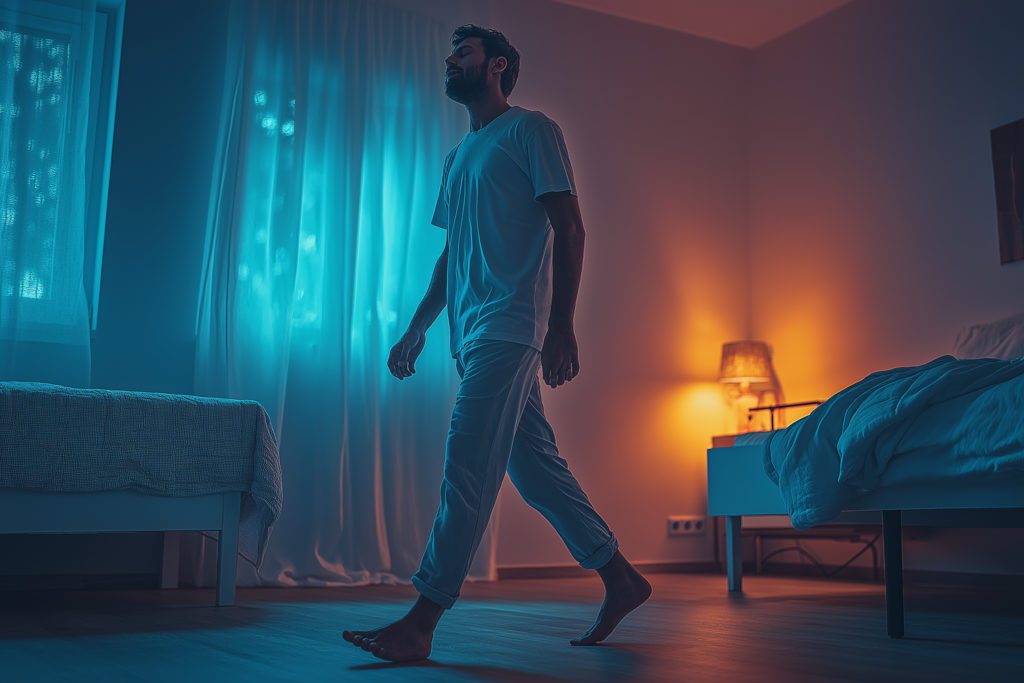
Sleepwalking in Adults: Causes, Risks, and Treatment Options
Learn what causes sleepwalking in adults, the dangers of sleepwalking,andhowtoreduce the risk of sleepwalking.

Are your nights less stationary than they should be? While sleepwalking is more common in children, adults can still be affected by this sleep disorder. It’s hard to gauge how many people are affected by it since those who sleepwalk are unaware of it—unless someone else tells them— but one meta-analysis suggests that sleepwalking affects 5% of children and 1.5% of adults.
The age-old adage is to never wake someone who is sleepwalking, but is there anything else you can do to handle sleepwalking episodes and prevent dangerous situations? We’ve compiled a guide to help you manage this sleep disorder, understand what may cause its appearance, and explore the available treatment options.
Understanding Sleepwalking
Formally known as somnambulism, sleepwalking is a behavior-based sleep disorder where someone walks or performs other complex behaviors while still asleep. It is a type of parasomnia, which are sleep disorders that straddle the line between being asleep and awake. Like most other parasomnias, sleepwalking originates during deep sleep, or the third stage of the sleep cycle.
Even though the name “sleepwalking” suggests that the abnormal behaviors are limited to walking, sleepwalking episodes can include other simple or complex actions, such as running and moving objects.
The time limit of sleepwalking episodes can also vary, with some episodes over in just a few seconds and others extending to half an hour. At the end of an episode, someone may return to bed on their own or wake up confused about their surroundings and how they got there.
In adults, a sleepwalking episode may include:
- Open, glassy eyes with a blank look on their face
- Walking or running
- Routine actions, like getting dressed
- Minimally responsive or incoherent speech
- Urinating in inappropriate places
- Engaging in sexual behavior
Less commonly, the behavior may be more complex, such as trying to drive a car, or it may be violent.
A key feature of parasomnias, sleepwalking included, is that the person rarely remembers the episode when they wake up, so they often learn about their sleepwalking from a family member or roommate. Additionally, these episodes usually occur during the first half of the night since that is when we spend a higher percentage of our time in deep NREM stages.
It’s Not All Fun and Games: The Dangers of Sleepwalking
It may seem amusing to watch the antics that a sleepwalker gets themselves into during the night, but there can be some serious dangers associated with this sleep disorder. Injury, especially, is a significant concern as those who are still sleeping move around the house. Tripping or banging into objects can be common, and for those who run during their episodes, the damage can be even worse.
Some people may grab sharp objects during their episode or try to drive a car, actions that can be life-threatening. Additionally, if a sleepwalker exhibits aggressive behavior during episodes, they may cause harm to themselves or others.
Besides these physical damages, sleepwalking can also cause mental damage in the form of embarrassment. Some people may urinate in the wrong place or exhibit sexually explicit behavior during sleepwalking episodes, actions which can cause embarrassment come morning.
As a sleep disorder, sleepwalking also impacts your sleep quality, which can lead to excessive daytime sleepiness and cause diminished cognitive abilities (thinking, reasoning, decision-making) and slower reaction times.
What Causes Sleepwalking?
Experts believe that sleepwalking occurs when you’re in deep sleep and are partially awoken in a way that triggers physical activity.
Some things that may cause this partial awakening include:
- Family history. A study found that 47% of children sleepwalk if one parent has a history of it, and 61% in both their parents do.
- Alcohol. Drinking alcohol at night can mess with your sleep stages and potentially increase your risk of sleepwalking.
- Sleep deprivation. The risk of sleepwalking increases if you haven’t been getting enough sleep, possibly because your body makes up for sleep deprivation by spending more time in deep sleep the next time you’re in bed.
- Medications with sedative effects. These medications may push you into a type of sleep that can make sleepwalking more likely.
- Co-existent sleep disorders. Sleep disorders such as obstructive sleep apnea and restless leg syndrome cause nighttime wakings, which may cause you to enter a sleepwalking episode.
- Stress. Stress can cause more fragmented sleep, which can increase the possibility of sleepwalking.
Managing Sleepwalking
There is often no need for active treatment of sleepwalking because the episodes are rare—especially in adults—and usually cause little risk to the sleepwalking individual or those around them.
However, following these tips can help prevent the likelihood of sleepwalking and ensure that, if you become mobile in your sleep, you’ll remain safe.
Treat Underlying Causes
Consider what may be affecting your sleep and placing you in a position where sleepwalking is more likely, and seek treatment. For example, if it is occurring because you have a sleep disorder such as obstructive sleep apnea, treating it can improve your sleep, reduce nighttime wakings, and limit the possibility of sleepwalking.
Improve Sleep Hygiene
Sleep deprivation is a significant cause of sleepwalking, but by improving your sleep hygiene and getting more quality sleep, you can reduce this risk factor.
Some ways to improve your sleep hygiene include:
- Following a sleep schedule
- Creating a relaxing bedtime routine
- Sleeping in a cool, dark, and quiet room
- Avoiding alcohol and caffeine before bed
- Exercising earlier in the day
Eliminate Safety Risks
If you sleepwalk, harm reduction is important and may even ease your mind to help you sleep better. You can focus on your safety by:
- Closing and locking doors and windows
- Keeping sharp objects locked away
- Installing lights with motion sensors
- Removing tripping hazards from the floor
- Using a door alarm that goes off if a door is opened
Seek Professional Help
If addressing underlying causes and improving your sleep hygiene is not enough to stop your sleepwalking, and if the episodes occur frequently, it may be time to contact your doctor for assistance.
Cognitive Behavioral Therapy (CBT) is a form of talk therapy that can help improve sleep and reduce stress and anxiety associated with sleep, which can help reduce stress-induced sleepwalking episodes. You could also inquire about medication, of which antidepressants and benzodiazepines have been used to treat parasomnias.
Sleepwalking in Adults: What to Do
If you or someone in your house sleepwalks, knowing how to handle and prevent sleepwalking episodes is key.
It’s generally advised not to jarringly wake the sleepwalker, as that may provoke confusion, fear, or anger. Instead, try lightly guiding them back to back with a quiet, soothing voice and gentle touch.
Once they (or you) wake up, try discussing ways to reduce the risk of sleepwalking, including improving sleep hygiene, treating underlying causes, and seeking medical help. The sleepwalker will be safer, happier, and more well-rested if you do.
FAQ
What is sleepwalking, and when does it happen?
Sleepwalking, or somnambulism, is a parasomnia where a person walks or performs activities while still asleep. Episodes typically happen during deep sleep, usually in the first half of the night.
What types of behaviors are common during sleepwalking episodes?
Common actions include walking, running, performing routine tasks like dressing, and sometimes talking incoherently. In rare cases, behaviors can be more complex or even risky, like attempting to drive or handling objects.
What causes sleepwalking in adults?
Causes can include genetics, sleep deprivation, alcohol consumption, stress, medications, and other sleep disorders, like sleep apnea. These factors may disrupt deep sleep, triggering sleepwalking episodes.
Is sleepwalking dangerous?
Yes, sleepwalking can lead to injuries from tripping or bumping into objects, and in severe cases, sleepwalkers may try dangerous activities, such as driving. Embarrassment from certain actions, like urinating inappropriately, can also cause distress.
How can I prevent sleepwalking episodes?
Improving sleep hygiene by maintaining a regular sleep schedule, avoiding alcohol, and reducing stress can help. Locking doors and windows, removing tripping hazards, and using door alarms can also reduce risks.
When should someone seek professional help for sleepwalking?
If sleepwalking episodes are frequent, dangerous, or causing emotional distress, it may be time to consult a doctor. Treatment options can include cognitive-behavioral therapy (CBT) and, in some cases, medication.
What should I do if someone is sleepwalking?
Gently guide the person back to bed without abruptly waking them, as sudden awakening can cause confusion or aggression. Speaking calmly and using gentle touch can help.

Written by
Jessica G.
Medical writer freelancer who has written hundreds of articles on varying topics. Masters of Engineering degree in Biomedical Engineering.
Download Pillow
Get help
Press & News
Legal
Connect
X (Twitter)
Company
Copyright © Neybox Digital Ltd.



